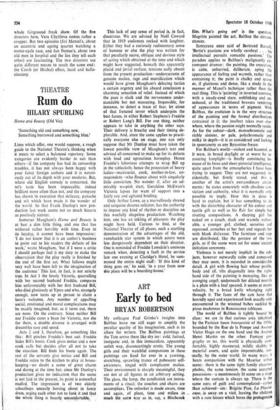Early to bed
ART BRYAN ROBERTSON
My colleague Paul Grinke's insights into Balthus leave me still eager to amplify the peculiar quality of his imagination, such is its allure for writers. The Balthus paintings at the Tate arrive there like dry ice : cold, factual, inorganic and, in this immaculate, apparently unfelt way, disconcertingly erotic. The young girls and their watchful companions in these paintings are fixed for ever in a yawning, stretching, sprawling trance of pubescent self- awireness, tinged with complacent malice. Their environment is sharply meaningful, they are not at all figures in an arbitrary setting. The glass, the lamp, the candlestick are instru- ments of a ritual; the couches and chairs are accomplices. The onlooker is made aware, time and again, of .place, time and milieu in much the same way as in, say, a Hitchcock
film. Whats going on. is the question. Magritte painted the act, Balthus the circum. stances.
Santayana once said of Bertrand Russell, 'Bertie's passions are wholly cerebral . . his intellectual pursuits romantic passions.' The paradox applies to Balthus's malignantly cir- cumspect dramas: the painting, the execution, is calm, unhurried, deliberate, aping the appearance of feeling and warmth, rather than containing it; the paint is chalky and sparse or, if glutinous and dense, like a study in the manner of Manet's technique rather than the real thing. This is 'painting' in inverted commas, with a steady-eyed stare, unblinking and un- seduced, at the traditional bravura rendering of appearances in terms of pigment. With Balthus, the eroticism is in the very structure of the painting and the formal distributions contained in it; the intellect takes over else- where, where the passion might normally reside. As for the colour—dark, monochromatic and richly sinister, or pale, polychromatic and milky in depth—it is as considered and lacking in spontaneity as any Byzantine fresco.
For Balthus's world—violent and haunted, as it were, in broad daylight or at worst by re- assuring lamplight—is finally convincing be- cause of its force and sheer pictorial intelligence, quite apart from the atmospherics I have been trying to suggest. They are not suggested, in- cidentally, but firmly stated, and this is another of the artist's extraordinary attain- ments : he states concretely with absolute con- viction and authority, what it is normally only possible to imply. How this is done is hard to explain, but it has something to do with the disturbing character of his colour and tactile gift as well as his flair for simple but riveting compositions. A sleeping girl lies naked on a couch, slack and warmly vulner- able, a younger girl, clothed, secretive and repressed, crouches at her feet and regards her with blank disfavour. The furniture and rugs are distributed, like the posture of the two girls, as if the scene were set for some ancient initiation ceremony.
Violence is not merely implicit in the sub- jects, however outwardly calm and composed they may seem, it is recorded in considerable detail. A girl with flowing hair whose profile, body and all, tilts diagonally into the right- hand side of the painting is menacing, like an avenging angel; underneath her dilated nostrils is a plate with a loaf speared, it seems at manic velocity, by a- bread knife whanging right through it. The faces of the cats have that horridly aged and experienced look usually only encountered in the wizened babes suckled by pious madonnas in Renaissance. tableaux.
The world of Balthus is tightly bound by class : we are in that curious area inhabited by the Parisian haute bourgeoisie of the 1930s. bounded by the Rue de la Pompe and Avenue Victor Hugo on the one hand and the Avenue Henri Martin on the other. Fantasy geo- graphy or no, this world is physically com- fortable, highly mannered, mildly shabby in material assets, and quite impenetrable, nor- 'many, by the outer world. In' many ways, it bears comparision with the Mauriac urban scene : there is the same tight, family claustro- phobia, the same tension, the same accepted possessions—a montonously lit scene on a stage where the curtain is always up. There is the same aura of guilt and contemplated—rather than achieved—sin: Brigitte „Plan, La Pharisi- - erne, is away. on a visit, leaving the children with a rare leisure which bores the protagonists
as much as it corrupts them. The landscapes of Balthus, classically charged and monumen- tal though they are, are similarly touched by impending darkness. Only the recent painting of a Japanese model, reclining odalisque-like in a richly patterned interior, seems free of violence, serenely erotic and with the pale clarity of winter sunlight.







































 Previous page
Previous page